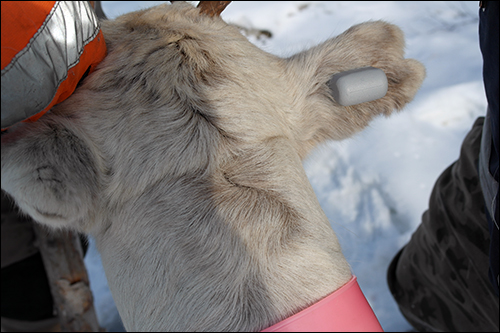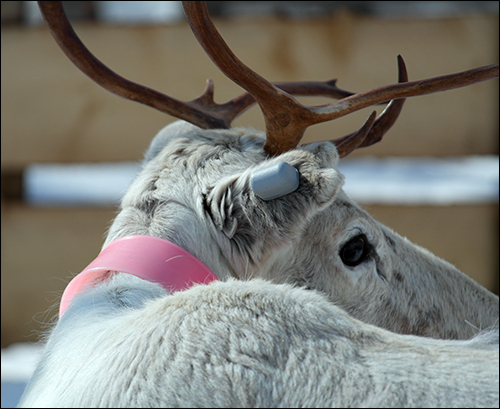Finnish technology startup Anicare is providing its Healtag tracker to be attached to the ears of reindeer so their movements can be tracked across Finland for as long as five years. The solution employs Nordic Semiconductor‘s Internet of Things (IoT)-enabled tag, which is built into an ear tag that can be attached to an animal’s ear flap. The tag transmits its unique ID number, along with location data, via what is called narrowband IoT (NB-IoT), a low-power wide-area network (LPWAN) for cellular devices.
The system employs a cellular connection to Anicare’s cloud-based server in order to enable users to not only see where animals are but when they may require assistance, based on their lack of movement. Anicare also offers an app so that a herder can access data regardless of where he or she is located.

Anicare was launched in 2012 to help reindeer herders manage their animals. Reindeer are livestock, but they pasture for most of the year in unconfined forests without any human oversight. This exposes them to various hazards. Although reindeer move in herds, some become separated from their group. Because the forests are vast and remote, herders may never know what became of a lost animal. If it falls ill, is attacked by a predator, is otherwise injured or dies in the forest, the animal is often never found.
Aki Marttila, the company’s founder, says he came upon dead reindeer in the forest and wondered if there might be a technology-based solution to the problem. “I own reindeer myself,” he explains, “and I’m part of the Reindeer Society, [the Reindeer Herders’ Association (RHDA)], so I started to think it might be possible to make a device” from which all herders could benefit.
Some reindeer already wear GPS collars, and have done so since 2009. However, Marttila says, such devices can cost around €600 ($784) apiece. The battery life is typically about a year, meaning herders would need to change the battery on any given animal’s device multiple times throughout its life. That requires catching each animal and handling its collar, which creates stress for both the reindeer and its owner. The GPS transmitters are also heavy, due to the batteries needed and the size of the radio hardware.
For that reason, they must be applied to a collar rather than being attached more discretely to the ear. But Marttila argues that putting collars on reindeer isn’t desirable for several reasons, including aesthetics. Tourists often come to see the reindeer, he notes, adding, “Really bright colored and wide collars on reindeers don’t give a very good experience for tourists” who hope to see wild animals, not reindeer in “dog collars.” He adds, “From this point of view, I wanted to offer a product that fits into reindeers’ ears where they are not so visible,” and that won’t pose any potential harm.
In a different application, Digita has been testing a low-range wide-area network (LoRaWAN) and GPS-based version with the FRHA in some parts of Finland (see IoT Aims to Track Free-Ranging Reindeer in Finland). Anicare offers an alternative to LoRaWAN in the form of NB-IoT.
“When I heard that NB-IoT came to reality,” Marttila says “I started to develop the product.” The system consists of a Nordic nRF9160SiP cellular radio (which supports the NB-IoT and LTE-M network standards) built into the device, which can be fastened directly to a reindeer’s ear. It is small and lightweight, he says, and comes with a GPS unit, an accelerometer and a temperature sensor.

The Healtag sends its data, including its own unique ID and GPS coordinates, to existing cellular gateways via NB-IoT. As an animal grazes or migrates, its location is continually updated. As the cloud-based software collects each animal’s location, that data can be displayed on a dashboard. Owners can then access the system and gain a real-time view into where the animals are located, as well as where they have been and how much they have traveled. In addition, the system comes with an app so herders can view the data on their mobile phones in real time.
An alerting function in the system can notify authorized parties in the event that a problem is detected with a particular animal. If the system detects that it has stopped moving (based on the accelerometer algorithms) or that it seems to have a health problem (if the temperature sensor finds a sudden drop in temperature), the software will capture that data and identify the problem, under the assumption that the animal either has been hurt or has died. The owner or herder can then receive an alert on his or her app indicating the problem and its location. “In that way,” Marttila explains, “they can find the animal as soon as possible.” Herders can also use the app to request the current position of a specific reindeer at any given time.
The technology has been tested throughout the past year, Marttila says, and more pilots are scheduled in the future, with a new version of the tag slated for release this summer, following some improvements. The tags that were applied to reindeer last summer are still being tracked as the animals move around the Lapland area seeking the best grazing spots. The initial test results, he reports, “were very promising,” and he expects the technology to be made commercially available at the end of this year.
Herders testing the system are spread across Lapland, Marttila says, and more herders will be added in other geographical areas around Finland to continue testing the data access in all regions. Once commercially released, the solution will be available to herders at the cost of the license fee for software, while the application used on their mobile device will be free. In the future, Anicare expects to begin testing the technology for use with cows and sheep as well.


